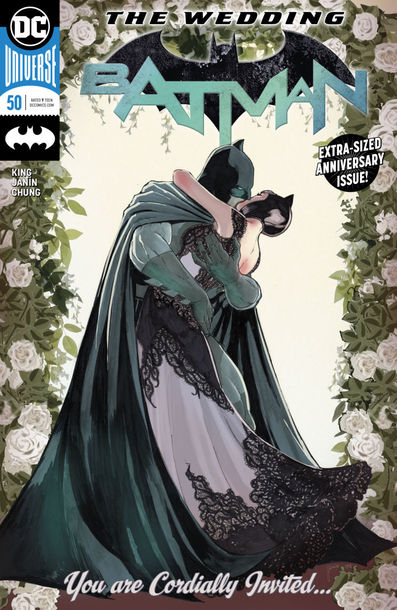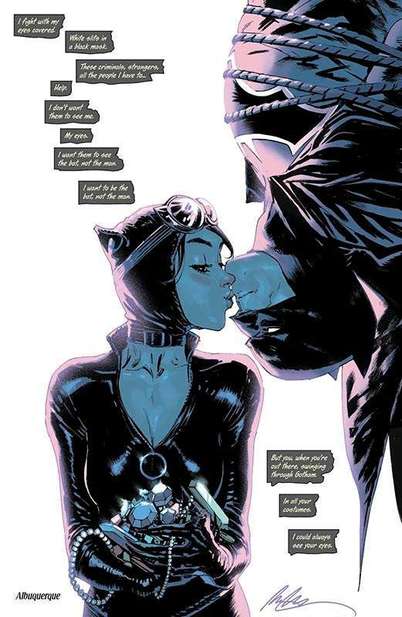Written by Joel T. LewisTHIS IS THE EMERGENCY SPOILER ALERT SYSTEM...YOU ARE ADVISED TO READ AT YOUR OWN RISK... To be honest my initial reaction to turning the final pages of the greatly anticipated Bat/Cat wedding issue was deflated. Spoiler alert: Selina decides she can’t go through with the wedding and Bruce is left alone on a rooftop and it is strongly implied that Bane is ultimately responsible for the aborted nuptials. I’m not sure what I wanted from this issue, and while I can reason out Tom King’s logic for not allowing the Bat and the Cat to tie the knot I suppose what I’m most frustrated by is the titillation. Let me explain. If we trace Bruce and Selina’s fourth quarter, hurry up courtship, back to its origin in the series, it comes out of ‘The Button’ story arc’s resolution of the Flashpoint continuity in Flash no. 22. That universe’s Batman, Thomas Wayne finally communicates to Bruce his desire for his son to find some way to be happy and tries to express to him that his quest for vengeance as Batman is not something his parents ever wanted for him or expect from him. Two short issues later Bruce proposes to Selina. Now from the jump this move raises certain red flags, flags that I initially overlooked in my excitement to see the two married. Bruce reaching out as a gesture of vulnerability and intimacy in his proposal to Selina shows a side of the Dark Knight that seldom sees the light of day, and the characterization offered by the issues that followed the ‘War of Jokes and Riddles’ flashback arc outlining the importance of the other relationships in Bruce’s life were poignant and moving. However, the fact that Bruce’s first instinct to ‘try to find a way to be happy’ as his father suggests is to find happiness in a relationship is wildly problematic. The consequent codependency suggested by that plan pointed to a partnership that could never truly be a partnership, as Bruce’s belief that an outside force could be the key to his own happiness would unfairly unbalance the support structure of the relationship. This marriage could never be maintained with that undercurrent of codependency. Also, the argument that Selina offers Bruce in her letter, that their potential marital bliss could lead to the end of the Batman as we know it is also a valid point to make. Bruce has never been truly happy, and neither we as the audience or Bruce himself know if Batman exists if Bruce is happy. So, my dissatisfaction with the outcome of the issue does not stem from a conflict in the logic of the two not going through with the marriage, but rather with the way King uses the hypothetical marriage of the two in his story. Now, as I read the lead up and prelude to the wedding issues what really interested me were all of the trappings of the hypothetical wedding ceremony to come: Who would be best man, what the parties both bachelor and bachelorette would look like, and how would Joker try to ruin the ceremony. And as we came closer and closer to the fateful day all these sweet little components were assembled: Catwoman stealing her wedding dress, Bruce and Clark Kent’s revelations to Selina and Lois about how deeply they respect each other and the utterly bro-mantic double-date they share with the women they love, and Dick Grayson’s understanding of Bruce and Clark’s friendship and his contentment rather than jealousy with the notion that Bruce might choose the Man of Steel over the Boy Wonder as his best man. I dreamed of a line of former Robin groomsmen in their tuxedos on one side of the altar and a chaotic tangle of villains on the other with Damien serving as ring bearer and a manic Joker officiating sporting a priest’s collar and all. Now my supposed expectation for what King’s Wedding issue was to be is no basis for criticism of the actual event (or lack thereof), but I’m still struggling to encapsulate the exact frustration I’m experiencing with regards to issue 50. I believe it stems from a primary mis categorization of terms that would be on the one hand uniquely clever from a narrative point of view (if they were intentional of course) despite the unsatisfying end reached or a cheap ploy banking on fan fervor and sensationalism. I’m talking about the Wedding itself. My understanding, and I don’t believe it to be a false one, of the literary concept of a Wedding is as an event, as the central focus of a scene, subplot, or entire story and when Bruce knelt down on that rooftop in issue 24 that’s how I framed my expectations for the story to come. The way King uses the Wedding is not as an event, but as a setting instead. The Wedding never occurs, but the deeper exploration of characterization and the events that led up to the hypothetical Wedding can only take place within the narrative wherein the Wedding is going to happen. The setting, or perhaps, narrative context that the impending nuptials creates is the only place in which the character-driven storylines, specifically those involving Bruce’s relationship with Clark Kent, Talia Al Ghul, and the Bat Family and Catwoman’s relationship with the villains of Gotham City can occur, but it is not necessary for the Wedding to ever occur in order to tell those stories. This is really quite clever. But, and this is the thing that really frustrates me, the Wedding as Event and the fervor created by the notion of even a hypothetical wedding between Batman and Catwoman and the long-term implications of that event for those characters seem like a cheap ploy to garner interest and excitement banking on a deliberate mis categorization of terms.  Within the first page’s panels of issue 50 Tom King undermines expectations of the Wedding as a traditional ceremony as Bat and Cat agree to a rooftop rendezvous with a single witness apiece and a drunken judge officiating. No Wedding party, no reception, no gifts, no pomp no circumstance. What the issue actually explores is beautiful in its own way but the initial disappointment, dissatisfaction felt when we realize that no wedding is going to take place is a sizeable hurdle to overcome in order to appreciate what King actually does, rather than what he primed his audience to expect. Now no author can control what their audience will blow up or fixate on as they set up a storyline, but the set-up in this case is a bit ridiculous. It’s been just over a year since the proposal issue of Batman no. 24 and in that time, we’ve been treated to an 8-issue deviation for the ‘War of Jokes and Riddles Arc’ (which I can’t complain about too much having loved that storyline) but also 5 Wedding Prelude issues and a wibbly-wobbly, timey-wimey Booster Gold Arc. Now I can’t say that the blame is entirely King’s in this case, and I understand the desire to give the Wedding issue an iconic issue number, but this ‘tune in next year’ marketing strategy is becoming more of an issue, especially for DC Comics. Take the Rebirth/Doomsday Clock release schedule for example: DC Rebirth 1, with its iconic Dr. Manhattan tease at the end was released May 25, 2016 but the first real threads of the larger DC/Watchmen crossover to come didn’t show up in the comics until ‘The Button Arc’ on April 19, 2017 with Batman no. 21. That’s 10 months, 20 issues of every DC hero book before picking up the threads of that monumental tease and after that we got a 4-issue crossover arc that focused more on wrapping up the loose ends of the Flashpoint Event than providing any more details on the Watchmen crossover. Then readers had to wait 6 months for the November release of the first issue of ‘Doomsday Clock’, a 12-issue mini-series that’s been plagued by delays and shifted to a bi-monthly release schedule, so instead of being 8 issues in as was planned, issue 6 won’t be available until the end of August. Now no one can predict creator delays, and I would much rather have an issue mulled over and perfected over one that was rushed to press, but I'm not sure what logic DC are subscribing to with these extended hype campaigns. They don’t end up sustaining reader interest which would be a valid marketing strategy. Instead they set up wildly unachievable expectations and inspire only reader fatigue as tiny seeds of a storyline are spread across 6-12 month periods. Now all that being said, this is a landmark issue in the history of Batman and Catwoman’s relationship, (I am tempted call it the definitive issue of the relationship) and will inform much of how the characters are written from now on. King manages to pull off a pretty monumental reversal in this issue. Previously, Bruce has always put the mission before everything else; his friends, his surrogate family, his own life. At the end of his letter to Selina we see Bruce’s desire and consequently his ability to become greater than his mission, and it’s Selina’s letter than bends to the power, the will of the Batman’s crusade. She is the one who sacrifices their possible happiness in order to keep the Batman intact. It’s not out of fear, or flightiness, out of selfishness, or insecurity; Selina leaves Bruce on that rooftop because she understands that Batman is greater than either of their feelings. Previous to this issue it was always Bruce’s commitment to the crusade which prevented him from pursuing intimacy, but in this issue, he sees the power of what he’s created as it has become too essential to Gotham for Catwoman to do anything to jeopardize it. I would also be remiss to not mention what I considered to be uncontested highlight of the issue: the artwork. As we read the letters sent between Bat and Cat, 21 artists lend their pencils to cataloging the ups, downs, leaps, and bounds of the pair through their shifting styles over the years of their courtship. As each artist encapsulates a different era, style, or stage in their relationship, you watch as the decades long game of femme fatale and dark knight unfolds, deepens, and becomes intimate. Analyzing each of these page length masterpieces could fill an article all its own, but if I were to just mention my personal favorites I’d say that I never grow tired of Frank Miller’s Catsuit, the not so subtle smirk in the final panel of Tim Sale’s page was refreshing in its boyish charm, Rafael Albuquerque’s is playful and beautiful, and finally Lee Weeks’ stark minimalist page is breathtaking. In summary, while iconic, essential, and clever, issue 50 is ultimately underwhelming and unsatisfying as a result of poor marketing and King’s leaning heavily on and then undermining the mis-categorization of the Wedding as an event rather than a narrative context. The artist’s brought their A Game in tribute to the body-suited beaus and their contributions to this iconic issue will not be soon forgotten. Until Next Time, Geek On!
0 Comments
Leave a Reply. |
Archives
May 2024
|
|
© 2012-2025, Nerds That Geek LLC.
All Rights Reserved. |
uWeb Hosting by FatCow
